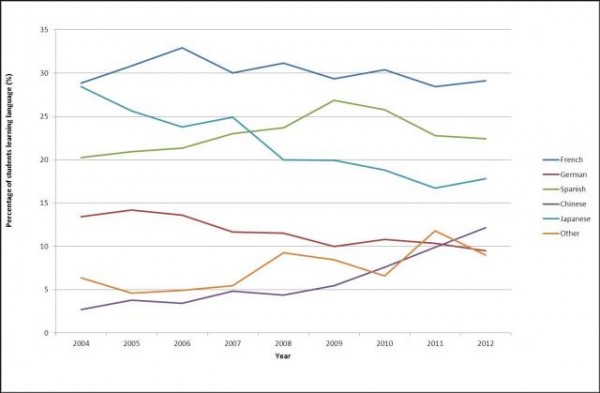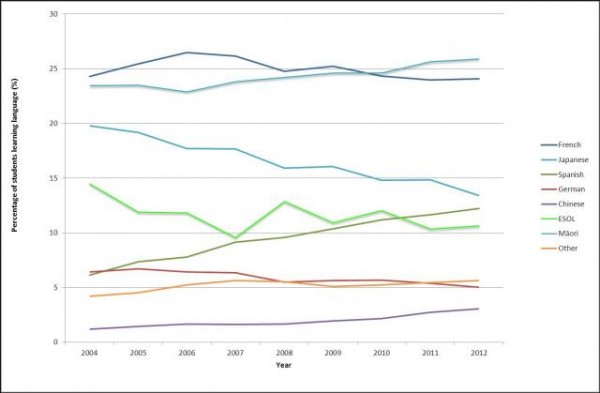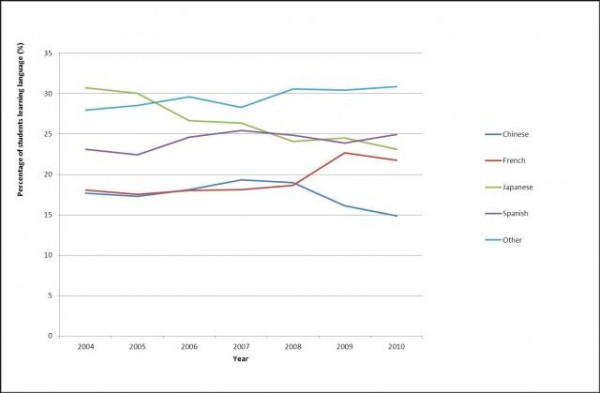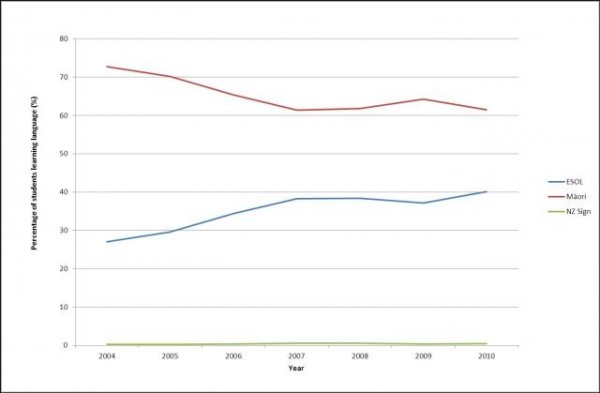Language plays a critical role in all our lives; it determines who we interact with and how we are perceived. Learning a language can also help us learn about our heritage or connect with a culture different from our own. It can also bring employment or business opportunities. For most of us, learning a language starts in school.
Table 1 shows the number of students learning an ‘international language’ (a language other than an official New Zealand language) at primary school, secondary school or a tertiary institution between 2004 and 2012. The numbers of students studying any given language is dependent on a number of inter-related factors, including the personal choice of students and their families, the availability of teachers, and decisions by school boards.
Table 1: Number of students learning International and New Zealand languages at primary, secondary and tertiary level in New Zealand, 2004-2012
|
|
2004 |
2005 |
2006 |
2007 |
2008 |
2009 |
2010 |
2011 |
2012 |
|
Primary School |
85,016 | 85,632 | 83,316 | 95,171 | 99,760 | 88,544 | 106,686 | 102,888 | 108,356 |
|
Secondary School |
105,802 | 102,734 | 104,331 | 104,305 | 114,005 | 107,771 | 98,070 | 96,923 | 92,940 |
|
Tertiary Level |
5,017 | 5,097 | 4,810 | 4,694 | 4,339 | 4,283 | 4,436 | NA | NA |
|
Teritary Level |
34,808 | 34,592 | 30,822 | 30,904 | 31,300 | 32,806 | 29,003 | NA | NA |
Source: Ministry of Education
Table 1 includes all of the students enrolled to learn a language. Where a person is learning more than one language, they have been counted in each applicable group. This data has been randomly rounded to protect confidentiality.
At secondary school level the data includes students studying ESOL (English for Speakers of Other Languages) and Te Reo Māori. These languages are not included in the data for the primary school level. The numbers of students learning Te Reo Māori, ESOL and New Zealand Sign Language at tertiary level is collected separately from those learning an ‘international language’ – this data is displayed in the last line of Table1 labelled ‘Tertiary Level (learning a New Zealand language)’.
Table 1 shows that the absolute numbers of students at primary school learning an international language are increasing, while the numbers of students learning an international language or New Zealand language at secondary and tertiary levels are decreasing.
Figures 1 – 4 below show the percentage of language students at each of these levels by the language they are learning.
Primary School
Figure 1: Percentage of primary school students learning a language by language learnt 2004-2012, (%)

Source: Ministry of Education
Figure 1 includes all of the students enrolled to learn a language. Where a person is learning more than one language, they have been counted in each applicable group. The source data for this graph has been randomly rounded to protect confidentiality. Percentages may not add up to 100%. Percentages have been rounded to the next full figure.
Between 2004 and 2011 the number of primary school students learning an ‘international language’ has grown substantially, from 85,016 students in 2004 to 108,356 in 2012.
Over this period French was the most popular language being learnt, with around 30 per cent of language students choosing French each year. Spanish and Japanese are the next most popular languages respectively.
In 2004 Japanese was the second most popular language with 29 per cent of language students learning it, but this has steadily declined to 18 per cent of language students in 2012. Spanish was the third most popular language in 2004 with just 20 per cent of language students; but by 2012 this had grown to 22 per cent of students – making Spanish the second most learned language at primary school level.
Of all the languages learnt by primary school students between 2004 and 2012, Chinese languages enjoyed the largest growth in the percentage of students learning it– growing from 3 per cent of language students in 2004 to 12 per cent in 2012.
Similarly, the ‘Other’ languages group, which consists of all other languages being learnt (each with less than 3000 language students learning it in any given year) also grew noticeably over this period – from 6 per cent of language students in 2004 to 9 per cent in 2012.
Secondary School
Figure 2: Percentage of secondary school students learning a language, by language learnt 2004-2012 (%)

Source: Ministry of Education
Figure 2 includes all of the students enrolled to learn a language. Where a person is learning more than one language, they have been counted in each applicable group. The source data for this graph has been randomly rounded to protect confidentiality. Percentages may not add up to 100%. Percentages have been rounded to the next full figure.
In contrast to primary school level, the number of students learning a language at secondary school has dropped significantly in recent years – from 105,802 students in 2004 to 92,940 students in 2012.
Since 2004, around 25 per cent of secondary school students learning a language have been learning French. Over this same period, the percentage of students studying Japanese has been in steady decline, from around 20 per cent in 2004 to 13 per cent in 2012. On the other hand, the percentage of students learning Spanish has doubled from 6 per cent in 2004 to 12 per cent in 2012. Chinese languages have not experienced the same growth in popularity at secondary level as at primary level. Only 1 per cent of secondary school language students were learning a Chinese language in 2004, and this grew to only 3 per cent by 2012.
While Te Reo Māori and ESOL were not included in Figure 1, Figure 2 shows that Te Reo Māori is the language with the highest percentage of language students with 26 per cent in 2012 (growing from 24 per cent in 2004). Participation in ESOL has been declining during this period, dropping from 15 per cent of language learners in 2004 to 11 per cent in 2012.
Tertiary Institutions
Figure 3: Percentage of tertiary students learning an International language, by language learnt 2004-2012, (%)

Source: Ministry of Education
Figure 3 includes all of the students enrolled to learn a language. Where a person is learning more than one language, they have been counted in each applicable group. The source data for this graph has been randomly rounded to protect confidentiality. Percentages may not add up to 100%. Percentages have been rounded to the next full figure.
In Table 1 the number of students studying a language at a tertiary Institution is much smaller than the number at primary or secondary school, with just over 4,426 students in 2010. As at secondary school level, the number of students has reduced noticeably from 2004 (at which time 5,017 students were learning a language).
As at primary and secondary school levels, the percentage of language students learning Japanese at tertiary level is declining rapidly, dropping from 31 per cent in 2004 to 23 per cent in 2010.
In contrast to both primary and secondary school levels, the percentage of language students learning Chinese languages at a tertiary institution is also in decline – from 18 per cent in 2004 to 15 per cent in 2010.
Figure 4: Percentage of tertiary institution students learning a New Zealand-based language by language learnt (%)

Source: Ministry of Education
Figure 4 includes all of the students enrolled to learn a language. Where a person is learning more than one language, they have been counted in each applicable group. The source data for this graph has been randomly rounded to protect confidentiality. Percentages may not add up to 100%. Percentages have been rounded to the next full figure.
Figure 4 shows the percentage of language students at tertiary level who are studying a New Zealand language – either Te Reo Māori, or New Zealand Sign language, which are official languages of New Zealand or ESOL (a conversational English language course for speakers of other languages).
The number of students studying a New Zealand language at a tertiary institution is much higher than those studying an ‘international language’ – in 2010 there were 4,436 students learning an ‘international language’ compared to 29,003 students learning a New Zealand based language. However, the numbers of students studying a New Zealand based language is also in decline, dropping from 34,808 in 2004.
The highest number of language students study Te Reo Māori, followed by ESOL. Very few students are learning New Zealand Sign Language at tertiary level.
The trends for Te Reo Māori and ESOL tertiary students is the opposite of what is occurring at secondary school Level. The percentage of tertiary language students studying Te Reo Māori is declining – from 73 per cent in 2004 to 61 per cent in 2010. At secondary school level the percentage of students learning this language has been growing. Also, the percentage of tertiary language students studying ESOL has rapidly grown, from 27 per cent in 2004 to 40 per cent in 2010. The corresponding group at secondary school level is declining.
